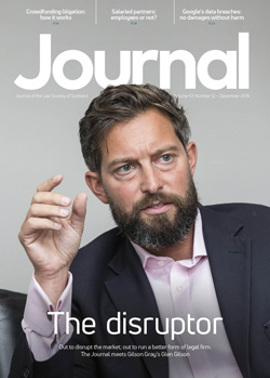Opinion: Mhairi Snowden

Ask most directors of NGOs in Scotland if they have an interest in using the law, including human rights law, to press for change to improve lives, and they will answer an emphatic yes.
Ask them if they have, or would ever, consider using litigation as a means to get change to improve lives, and the answer is more likely to be a “Well yes, but…”.
Few Scotland-based NGOs have taken court cases in their own name or have supported individuals in cases that raise systemic issues.
There have been some recent high-profile cases: for example, the case to ensure that rape survivors can access legal aid to challenge the use of medical records; the Humanist Society Scotland’s case on religious observance in schools; or Clan Childlaw’s intervention about a child’s right to privacy within the Named Person scheme.
However, these cases are the exception rather than the rule. This is important because where the human rights that we all have in law are being ignored, we need the courts to play their role in ensuring that they are enforced and that the rule of law is protected. It is effective and preferable for NGOs to support individuals or, better still, to bear the burden of going to court to raise such human rights issues.
We know that public interest litigation remains relatively rare in Scotland compared to elsewhere in the UK, and we decided to explore the reasons for this. Over the last year, the Human Rights Consortium Scotland, Clan Childlaw, Amnesty International and other partner organisations have been exploring the reasons for this paucity of strategic NGO cases. In our new report, Overcoming Barriers to Public Interest Litigation in Scotland, we identified five main barriers:
1. Poor access to information about court cases. There is a lack of information about ongoing, upcoming or closed cases. It is very difficult for NGOs, except by word of mouth, to know about cases. For NGOs, this makes interventions difficult, and an understanding and use of case law more difficult.
2. Issues around standing. The AXA case in 2011 established the “sufficient interest” test and raised expectations of a significant increase in organisations lodging judicial review petitions. However this has not happened, at least partly due to a continuing lack of clarity around the application of this definition. This absence of clarity about standing is accompanied by a lack of rules around interventions for procedures beyond judicial review.
3. Short time limits for taking cases. The time limits for legal action can be very challenging for organisations. Judicial review in particular is subject to a three month limit, which is a very short window for NGOs to organise resource, plans and permissions to support or take a case.
4. Inhibitive cost and financial risk. The court fees, risk of liability for the other side’s costs, and funding legal advice and representation can be just too risky for many organisations to consider. While protective expenses orders (PEOs) can be applied for, there are no court rules for PEOs beyond environmental cases and no readily available information about PEO decisions and their rationale. Where a case is in the public interest, there is merit in considering different rules around costs.
5. Limited culture of public interest litigation. There are a host of cultural and practical reasons that make NGO litigation involvement less likely in Scotland. These include aspects such as the smallness of the sector, perceived risk to reputation and funding, and a lack of understanding of the potential benefits of litigation. There is a significant dearth of partnerships between the NGO and legal sectors, with NGOs often not sure who to turn to, to discuss potential strategic cases and get legal opinion.
The findings of our report suggest that many of these barriers can be overcome, often by very practical changes and increased clarity. We encourage those working in law or policy in this area to make full use of this new report to instigate discussion, with a determination to remove the barriers to public interest litigation to better protect human rights in Scotland.
In this issue
- Brexit: looking to the future
- Trusting the specialist tribunal
- The single surrogacy saga
- Payment notices and strict forms
- Land registration errors: an owner's view
- Reading for pleasure
- Opinion: Mhairi Snowden
- Book reviews
- Profile: Caroline Court
- President's column
- Discharges made simpler
- People on the move
- Taking on all comers
- Crowdfunding: changing the legal landscape
- Salaried but not employed
- Putting customers at the heart
- Interviews and the minimum criminal age
- Data breaches and the damage test
- Steering away from breakdowns
- IT: the great leveller
- Admissible hearsay?
- Vicarious liability and the vindictive employee
- Upholding copyright or breaking the web?
- Smallholdings are different
- Avoiding bias in sports law disputes
- Scottish Solicitors' Discipline Tribunal
- Progress at the expense of accuracy
- In-house for initiative
- Have you completed your AML certificate?
- Public policy highlights
- A blurred vision
- Millennials: a new age for managers
- Into uncharted waters
- Lost will – what then?
- 2018: a paralegal view
- ... and the SPA looks back, and ahead
- Ask Ash






